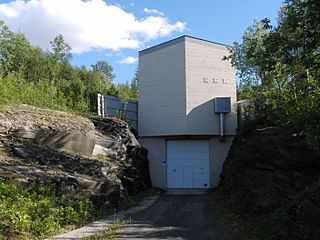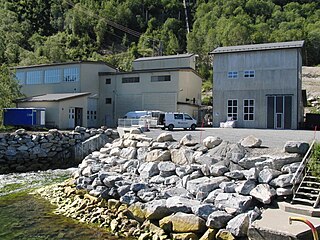
Ulla-Førre is a hydropower complex in Southern Norway. It is situated along the borders of the municipalities of Suldal and Hjelmeland and Bykle, Norway. It has an installed capacity of approximately 2,100 megawatts (2,800,000 hp), and the annual average production is 4.45 TWh (16.0 PJ) (1987–2006), while its reservoir capacity is about 7.8 TWh (28 PJ); at full production, it can last seven to eight months. The complex includes the artificial lake Blåsjø, which is made by dams around 1,000 metres (3,300 ft) above the sea level. The hydroelectric power stations in the complex are Saurdal, Kvilldal, Hylen and Stølsdal, operated by Statkraft.

The Tokke Power Station is a hydroelectric power station located in the municipality Tokke in Telemark, Norway, owned by Statkraft. It operates at an installed capacity of 430 MW, with an average annual production of 2,140 GWh. The power station exploits the height difference of 394 metres from the lake Vinjevatn to Bandak.

The Brandåa Hydroelectric Power Station is a hydroelectric power station in the municipality of Rindal in Møre og Romsdal county, Norway. It is a run-of-river hydro power station utilizing a drop of 373 meters (1,224 ft) in some tributaries of the Surna River. Permission was granted for construction in 2006 and the plant came into operation in 2009. It is operated by Svorka Produksjon AS. It operates at an installed capacity of 4.1 MW, with an average annual production of about 15.8 GWh.

The Gryta Hydroelectric Power Station is a hydroelectric power station in the municipality of Rindal in Trøndelag county, Norway. It is a run-of-river hydro power station utilizing a drop of 231 meters (758 ft) in a tributary of the Surna River. Permission was granted for construction in 2006 and the plant came into operation in 2009. It is operated by Gryta Kraft AS. It operates at an installed capacity of 1.49 MW, with an average annual production of about 4.5 GWh.

The Kysinga Hydroelectric Power Station is a hydroelectric power station in the municipality of Rindal in Møre og Romsdal county, Norway. It is a run-of-river hydro power station utilizing a drop of 135 meters (443 ft) on a tributary of the Surna River. Permission was granted for construction in 2009 and the plant came into operation in 2010. It is operated by Kysinga Kraft AS. It operates at an installed capacity of 1.25 MW, with an average annual production of about 6.5 GWh.

The Cårrujavrit Hydroelectric Power Station is a hydroelectric power station in Kvænangen Municipality in Troms county, Norway. It utilizes a drop of 305 meters (1,001 ft) between its intake reservoir on the Njemenaiko River and Little Lakes, which is also the reservoir for the Kvænangsbotn Hydroelectric Power Station. Lake Tjoika serves as the reservoir for the plant and is regulated at a level between 529 m (1,736 ft) and 516 m (1,693 ft). The plant has a Francis turbine and operates at an installed capacity of 1.7 MW, with an average annual production of about 11 GWh. The plant is controlled by Kvænangen Kraftverk AS, with a 48.2% share owned by Troms Kraft.

The Kvænangsbotn Hydroelectric Power Station is a hydroelectric power station in Kvænangen Municipality in Troms county, Norway. It utilizes a drop of 305 meters (1,001 ft) between its intake reservoir at Little Lakes and South Fjord. The reservoir is regulated at a level between 315 m (1,033 ft) and 305 m (1,001 ft). The Abo River is also utilized by the power plant. Water is supplied to the reservoir by the Småvatna, Lassajavre, and Cårrujavrit Hydroelectric Power Stations. The plant came into operation in 1965. In 1999 the company received a license to transfer water from the Brenn River, Šleađui River, and Olbmá River. The plant has a Francis turbine and operates at an installed capacity of 44 MW, with an average annual production of about 176 GWh. The plant is controlled by Kvænangen Kraftverk AS, with a 48.2% share owned by Troms Kraft.

The Lassajavre Hydroelectric Power Station is a hydroelectric power station in Kvænangen Municipality in Troms county, Norway. The plant utilizes a drop between Lake Abo and Lake Lassa. Lake Abo is regulated at a level between 689 meters (2,260 ft) and 669 m (2,195 ft), and Lake Lassa serves as the reservoir for the Småvatna Hydroelectric Power Station. The Lassajavre plant also utilizes water from Lake Mollis and Lake Sarves. The plant came into operation in 1977. It has a Francis turbine and operates at an installed capacity of 7.2 MW, with an average annual production of about 30 GWh. The plant is controlled by Kvænangen Kraftverk AS, with a 48.2% share owned by Troms Kraft.

The Småvatna Hydroelectric Power Station is a hydroelectric power station in Kvænangen Municipality in Troms county, Norway. The plant utilizes a 283-meter (928 ft) drop between Lake Lassa and Little Lakes. Lake Lassa is regulated at a level between 543 m (1,781 ft) and 519 m (1,703 ft), and Little Lakes serves as the reservoir for the Kvænangsbotn Hydroelectric Power Station. The Småvatna plant also utilizes water from Abo River and the Lassajavre Hydroelectric Power Station. The plant came into operation in 1969. It has a Francis turbine and operates at an installed capacity of 18.8 MW, with an average annual production of about 61 GWh. The plant is controlled by Kvænangen Kraftverk AS, with a 48.2% share owned by Troms Kraft.

Solbergfoss Hydroelectric Power Station is a run-of-the-river hydroelectric power station on the Glomma, in Indre Østfold municipality, Østfold county, Norway.

The Sjønstå River is a river in Fauske Municipality in Nordland county, Norway. The river is located in the valley between the town of Fauske and the village of Sulitjelma.

The Lomi Hydroelectric Power Station is a hydroelectric power station in Fauske Municipality in Nordland county, Norway. It utilizes a drop of 580 meters (1,900 ft) between its intake reservoir on Lomivatnet, which can be regulated at a level between 708 m (2,323 ft) and 649 m (2,129 ft). The reservoir is supplied by water from Storelvvatnan, a lake regulated at a level between 798 m (2,618 ft) and 792 m (2,598 ft), and also by some stream intakes. Part of the water supplying the plant is runoff from the Sulitjelma Glacier. The plant has two Francis turbines and operates at an installed capacity of 120 MW, with an average annual production of about 362 GWh. Its total catchment area is 145 square kilometers (56 sq mi). The plant is owned by Salten Kraftsamband and came into operation in 1979. The water is reused by the Sjønstå Hydroelectric Power Station further downstream in the Sulitjelma drainage system.

The Fagerli Hydroelectric Power Station is a hydroelectric power station in Fauske Municipality in Nordland county, Norway. It utilizes a drop of 232 meters (761 ft) between its intake reservoir at Nedre Daja and Langvatnet in Sulitjelma. The plant operates at an installed capacity of 48 megawatts (64,000 hp), with an average annual production of about 252 gigawatt-hours (910 TJ). It is owned by Salten Kraftsamband and came into operation in 1975. The Fagerli plant was the first one built by Salten Kraftsamband, in cooperation with Sulitjelma Mines.

The Daja Hydroelectric Power Station is a hydroelectric power station in Fauske Municipality in Nordland county, Norway. It is located about 2.3 kilometers (1.4 mi) east-southeast of Jakobsbakken.

The Forså Hydroelectric Power Station is a hydroelectric power station in Gildeskål Municipality in Nordland county, Norway. Part of the plant's catchment area also lies in Beiarn Municipality.

The Sundsfjord Hydroelectric Power Station is a hydroelectric power station in Gildeskål Municipality in Nordland county, Norway. Part of the plant's catchment area also lies in Beiarn Municipality.

The Langvann Hydroelectric Power Station is a hydroelectric power station in Gildeskål Municipality in Nordland county, Norway. It is sometimes referred to as the Langvatn kraftverk, which should not be confused with the Langvatn Hydroelectric Power Station in Rana Municipality.

The Oldereid Hydroelectric Power Station is a hydroelectric power station in Misvær in Nordland county, Norway.

The Grytdalen Hydroelectric Power Station is a hydroelectric power station in Valsøyfjord in the municipality of Heim in Trøndelag county, Norway. It stands about 1.8 kilometers (1.1 mi) south of the village of Engan. It is a run-of-river plant that utilizes a 50-meter (160 ft) drop from the lake Englivatnet to the intake dam of the Valsøyfjord Hydroelectric Power Station. It has a Francis turbine and operates at an installed capacity of 1.3 MW, with an average annual production of about 5.3 GWh. The plant came into operation in March 2012 and is owned by Svorka Energi.

The Skorge Hydroelectric Power Station is a hydroelectric power station in the municipality of Stad in Vestland county, Norway. Part of its catchment area lies in the municipality of Vanylven.




















